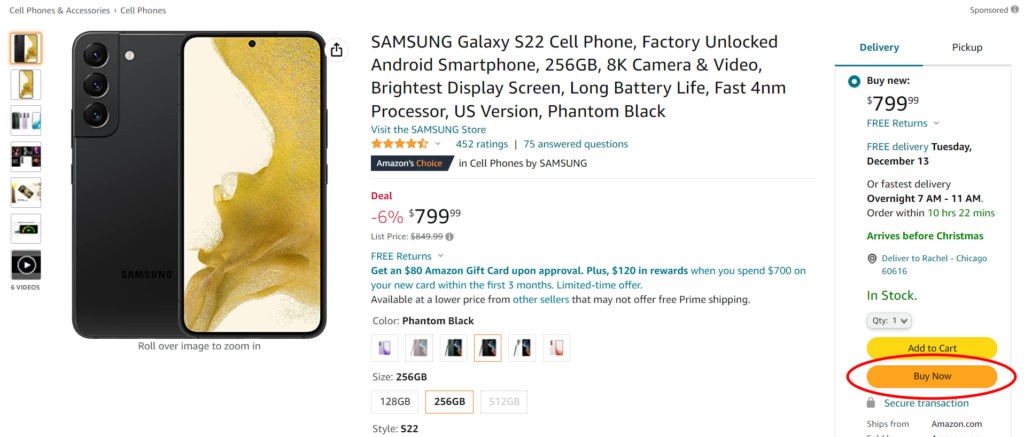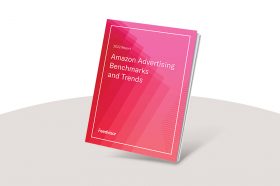Resources - Blog
M-Commerce is on the Rise: Are You Prepared?

Almost half of all Cyber 5 sales were made on mobile.
Mobile phones have become a necessity, and in most cases, an appendage, as 6.6 billion people use them daily to check messages, browse sites, watch videos, catch up with friends, and most recently, make more and more purchases.
Mobile purchasing has become so popular almost half of all Cyber 5 sales were made on mobile, and it is only expected to grow over the next few years. Insider Intelligence forecasts that U.S. m-commerce will nearly double its share of total retail sales between 2020 and 2025.
Paired with a rise in e-commerce sales, m-commcerce has nowhere to go but up. Is your mobile setup optimized? As an Amazon brand or seller, it’s time to start capitalizing on m-commerce.
Continue reading to learn more about m-commerce, what online marketplaces are doing to keep pace with the rise of mobile purchases, and what you can do to avoid being left behind.
Stay on top of the latest e-commerce and marketplace trends.
What is M-Commerce?
M-commerce or mobile e-commerce refers to a financial transaction shoppers make on mobile devices such as smartphones or tablets instead of desktop computers.
What is causing the rise in m-commerce? M-commerce typically refers to two key devices: smartphones and tablets. Though initial adaption to mobile shopping was slow due to difficulty checking out on small screens, the rise in popularity of smartphones has been a driving force behind the overall growth of m-commerce.
Part of the rise of m-commerce involves the rapid adoption of smartphones worldwide. There are 79% more smartphone users worldwide in 2022 than there were six years ago, growing an average of 10.4% annually. Of mobile devices that are used today, 76.9% are smartphones.

In 2021, retail m-commerce sales hit $359.32 billion, and by 2025 m-commerce sales are expected to more than double, reaching $728.28 billion.
Mobile commerce provides the convenience that many consumers seek, allowing them to shop from their couches, which became more normalized during the early stages of the pandemic when consumers were looking for ways to shop without physical contact with others.
What’s the Difference Between E-Commerce and M-Commerce?
E-commerce involves any transaction made online, while m-commerce refers to transactions made on or through mobile devices, including purchases made within the Amazon app. In short, m-commerce is a category within e-commerce.
Half of U.S. adults shop online at least once a week, and 16% do so on a daily basis.
Advantages to M-Commerce
Consumers make e-commerce their first destination because it provides the flexibility, convenience, and speed that they now come to expect. Half of U.S. adults shop online at least once a week, and 16% do so on a daily basis.
As online shopping has become more popular for consumers, consequently shopping also moved to mobile. You can thank the variety of technological advances that make it even easier to shop on a mobile device, such as the ability to view a product in a space before purchasing, 360 view options, and flexible payment options like Buy Now, Pay Later.

Following the growth of m-commerce, shoppers have been exploring new ways to find brands and products. Customers are now finding new products and brands through reviews on mobile sites like Amazon, livestreams on Twitch, and on social media sites like TikTok, from large influencers with millions of followers to smaller accounts with only a few hundred views.

Is Your Business Prepared for the Rise in M-Commerce?
Mobile commerce is growing, with Amazon leading the way for ease of purchasing by offering new features like Subscribe and Save, One-Click Payments, and email-only gift giving, popular during the holidays. If you are already selling on Amazon or other large retailers like Walmart and Target, you are one step ahead of many.
Listed below are a few different methods and features you can use to embrace m-commerce the same way consumers now do.
37% of consumers have made purchases after seeing Amazon influencers talk about or recommend them.
Features You Need to Include in Your M-Commerce Strategy to Stay Competitive
1. Optimized Social
Social commerce is a big part of the success of m-commerce and should be utilized by sellers on Amazon whether or not they have their own social media profiles.
But how can you optimize social without your own account? Amazon brands and sellers have learned how to begin utilizing social to bring more shoppers onto their listing through the use of influencers, including Amazon’s formal influencer program, one of the largest affiliate marketing programs.
Influencers will talk about and post about your products or brand with an affiliate link that goes to a personal storefront that links directly to your product on Amazon to better compete with new features that Facebook and Pinterest have introduced, like the “buy button,” allowing consumers to make purchases without even leaving the platform.
Amazon is also using livestreams to imitate other social platforms to bring in sales. According to Feedvisor data, 37% of consumers have made purchases after seeing Amazon influencers talk about or recommend them.
As app usage grows across social media sites, it will contribute significantly to sales growth, especially for Millennials and Gen Zers with huge spending potential. Read our newest Consumer Behavior Report to find out strategies you can take to reach the Gen Z audience and adapt to recent social commerce trends.
Buy Now, Pay Later usage increased 68% during the week of Black Friday compared to the previous week.
2. Variety of Available Payment Methods
Due to the nature of m-commerce, shoppers want to click, not think, and that includes during payment. This is seen in the adoption of mobile wallets, contactless credit cards, and newer “one-click” features on e-commerce.
Amazon Pay, in particular, has expanded beyond just in-Amazon purchases, being adapted to different markets and accessible to Amazon sellers that sell on other platforms off of Amazon, making it simple for your customers to checkout by letting them pay with their Amazon account.
Another offering on Amazon’s mobile app that many sellers on Amazon can include on their product page is “Subscribe & Save.” This feature allows consumers to choose to get the same items regularly, enabling the consumer to pick a timeframe to regularly purchase an item and helping the seller automate repeat customers.
Many retailers like Amazon have introduced one-click or “buy now” checkout to increase their sales and simplify consumers’ checkout experience, available both on mobile and desktop. This allows consumers to enter their payment once in an app and choose a one-click option every time to make purchases without re-entering credit card information.

Another huge growth area in payment methods includes Buy Now, Pay Later (BNPL), which was widely implemented during Cyber Five. BNPL usage increased 68% during the week of Black Friday (Nov. 21 to Nov. 27) compared to the previous week.
3. Personalized Advertising Experiences
Consumers aren’t just browsing and shopping on one device, meaning their advertising experience needs to follow their journey across devices. The average number of devices and connections per person globally is 2.4 and is predicted to rise to 3.6 by the end of 2023.
Utilizing DSP for advertising allows you to follow your audiences across websites, on all of their devices, including their TVs. Although the majority of shoppers are using m-commerce for their full browsing and check-out experience, there are still consumers that are waiting to make purchases on their desktops.
Amazon DSP is one of the most popular upper-funnel methods top advertisers use to follow their consumers’ journey on and off Amazon, allowing for in-depth re-targeting strategies. Learn more about how you can begin using Amazon DSP with Feedvisor.
Final Thoughts
The future of e-commerce is trending heavily mobile. Luckily, those selling on Amazon can take advantage of the mobile-friendly additions and updates Amazon has already been implementing. But to truly win with m-commerce, you need a strategy that combines advertising and pricing for a more holistic consumer journey across platforms.
Feedvisor offers an agency-like service paired with our AI technology to help you create successful Amazon DSP campaigns targeted for mobile, manage your PPC budgets, and create weekly performance reports for your entire business, all the way down to SKU level insights.
Mobile commerce isn’t going anywhere. What are you doing to keep up?





